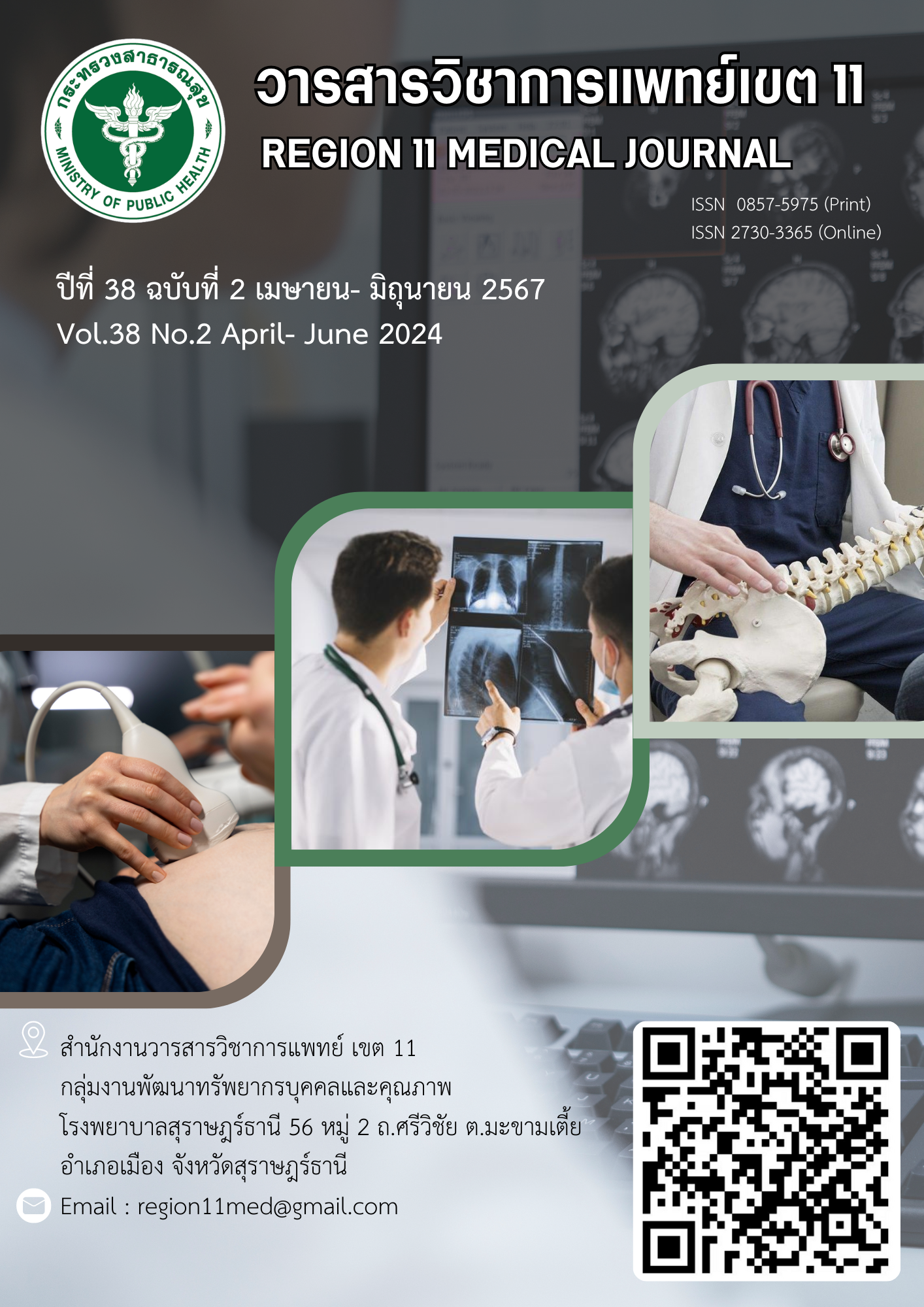Outcomes of Thungsong sepsis treatment protocol in sepsis management, Thungsong Hospital Nakornsrithammarath Province
Keywords:
Guideline, Mortality rate, SepsisAbstract
Introduction: Sepsis is condition with high mortality rate and current public health problem. The treatment process includes administration of fluids, rapid and empirical antibiotics, proper administration of inotropic drugs and eliminates the source infection.
Objective: To compare mortality rates and results of the treatment process before and after using the treatment guideline.
Methods: A quasi-experimental retrospective study. Collect all patient data from inpatient medical records who diagnosed sepsis and septic shock, pretreatment group from Jan 1 to June 3 2022 and post treatment group between July 1 and Dec 31 2022
Results: This study enrolled 169 patients before guideline implementation and 277 patients after the guideline. The outcomes showed an increase in ICU admission that went from 12.4% to 23.8% (P=0.04). Doctors that used the guidelines increased from 53.3% to 63.3% (P=0.01) and assessed early warning signs that rosed from 42.6 to 52.8% (P=0.02). By using the guideline, the duration of blood draw process for culture and initial antibiotics were increased from 30 minutes to 20 minutes (P<0.001). Treatment by the administering was more than 30cc/kg/hour of fluid in patients with low blood pressure (septic shock). It was found that after using the guidelines, fluid administration increased from 55.1% to 71.7% (P=0.042). The result of mortality rate after deducting palliative care decreased from 11.8% to 9%(P=0.339)
Conclusion: The results of the treatment process after using the guidelines were found that the treatment process improved. Meanwhile the results of mortality rate were not signifincantly decreased.
References
World Health Organization global report on the epidemiology and burden of sepsis. World Health Organization; 2018: 14-5
Kristina ER, Sarah CJ, Karea MA, Katya AS, Derrick T, Daniel RK, et al. Global, regional, and national sepsis incidence and mortality 1990-2017. Lancet. 2020; 395:200-11
อังคณา เกียรติมานะโรจน์. การพัฒนารูปแบบการดูแลผู้ป่วยที่มีภาวะติดเชื้อในกระแสเลือด โรงพยาบาลวาปีปทุม. วารสารวิชาการสาธารณสุขจังหวัดมหาสารคาม. 2563-4;5(9): 27-43
Panumgul L, Puwarawuttipanit W, Poungkaew A, Rongrungruang Y. Factor predicting sepsis in medical patient. Nurs SCI J.2021; 39 (3): 74-90
วีรยา ด่านเสนา, ยอดชาย สุวรรณวงษ์. ประสิทธิผลของรูปแบบการจัดการความเสี่ยงเชิงรุกเพื่อการเฝ้าระวังภาวะติดเชื้อในกระแสเลือดของแผนกผู้ป่วยในของโรงพยาบาลแก่งคอย.วารสารสถาบันป้องกันควบคุมโรคเขตเมือง. 2020-1; 5(2): 78-99
Joonghee K, Kyuseok K, Heeyoung L. Epidemiology of sepsis in Korea a population-based study of incidence, mortality, cost and risk factors for death in sepsis. Clin Exp Emerg Med 2019 :49-63
Khwannimit B, Bhurayanontacha R. The epidemiology of and risk factors for mortality from severe sepsis and septic shock in a tertiary-care university hospital setting Thailand. Epidemiol. Infect.2009; 137: 1333–41
Chanu R, Travis MJ, Yasir H, Anupam P, Jack V, Cara OB, et al. Prevalence underlying causes and preventability of sepsis-associated mortality in US acute care hospitals. JAMA Netw Open. 2019;2(2); 1-14
Mahantassanapong C. Outcome of the Surin sepsis treatment protocol in sepsis management Srinagarind Med J 2012; 27(4): 332-9
Andrew R, Laura EE, Waleed A. Survival sepsis campaign international guidelines for management of sepsis and septic shock 2016. Int care Med; 43(3): 1-67
Mitchell MY, Laura EE, Andrew R. The surviving sepsis campaign bundle 2018 update. Cri Care Med. 2018; 46(6): 925-8
Laura E, Andrew R, Waleed A, Massimo A, Craig MC, Craig F, et al. Surviving sepsis campaign international guidelines for management of sepsis and septic shock. Intensive care Med 2021;47:1181-247
Cheranakorn C, Chanchaichijit T. Use of delta modified search out severity (∆M-SOS) score for early detect clinical deterioration in mechanically ventilated patients. J Med Assoc Thai. 2021;104 (2): 219-24
Simon EL, Truss K, Smalley CM, Mo K, Mangira C, Krizo J, Fertel BS. Improved hospital mortality rates after the implementation of emergency department sepsis teams. Am J Emerg Med. 2022 Jan; 51:218-22
มั่นจิตต์ ณ สงขลา, สมศรี ซื่อต่อวงศ์. ผลการรักษาผู้ป่วยภาวะพิษเหตุติดเชื้อในโรงพยาบาลชลบุรี.วารสารวิชาการโรงพยาบาลชลบุรี 2564; 46(3): 179-88
ลัลธริดา เจริญพงษ์. อุบัติการณ์และปัจจัยเสี่ยงที่มีผลต่อการเสียชีวิตของผู้ป่วยติดเชื้อในกระแสโลหิตที่รับไว้รักษาในโรงพยาบาลเจ้าพระยายมราช.วารสารแพทย์เขต 4-5 2563; 39(4): 542-60
Tuttle E,Wang X,Modrykamien A. Sepsis mortality and ICU length of stay after the implementation of an intensive care team in the emergency department. Intern Emerg Med .2023;(18):1789-96
Seenprachawong B. Outcome of using clinical practice guideline for sepsis in Trang Hospital. Region 11 Med.2020 July-Sep; 34(3):35-46
Garcia-Lopez L, Grau-Cerrato S, Frutos-Soto A, Bobillio-De Lamo F, Citores-Gonzalez R, Diez-Gutierrez, et al. Impact of the implementation of a Sepsis Code hospital protocol in antibiotic prescription and clinical outcome in intensive care unit. Med Intensiva.2017; 41(1): 12-20
Ruttanaseeha W, Hurnmek S, lenghong K, Gaysonsiri D, Apiratwarakul K, Bhudhissawasdi V.Implementation of sepsis protocol for timely antibiotic administration in the Emergency Department. J Med Asso Thai 2020; 103(6) : 4-7
Matupumanon S, Sutherasan Y, Junhasavasdikul D, Theerawit Pongdhep.Effect of sepsis protocol in inpatient departments triggered by Ramathibodi Early Warning Score (REWS) on treatment processes. Clinical Critical Care 2023; 31(1):1-11
Downloads
Published
How to Cite
Issue
Section
License
Copyright (c) 2024 Region11Medical Journal

This work is licensed under a Creative Commons Attribution-NonCommercial-NoDerivatives 4.0 International License.






